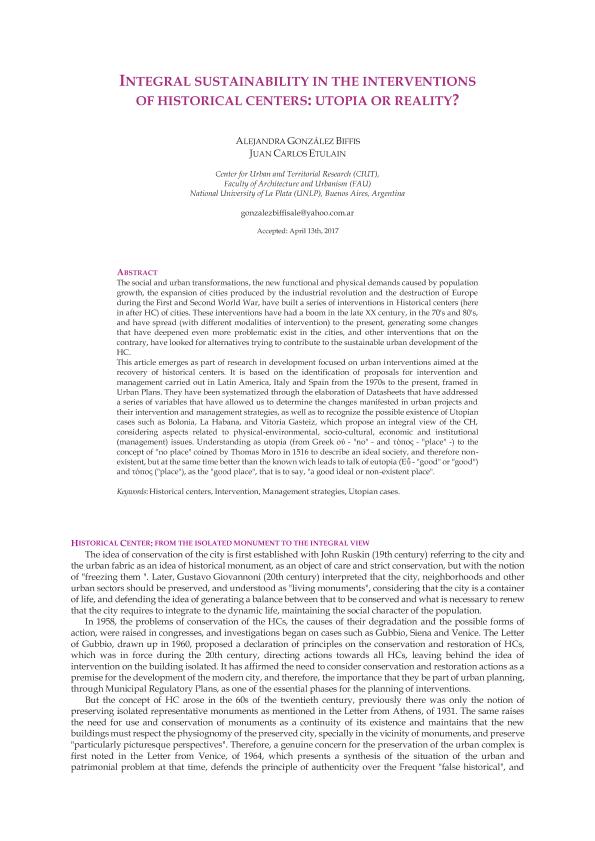Mostrar el registro sencillo del ítem
dc.contributor.author
Gonzalez Biffis, Alejandra

dc.contributor.author
Etulain, Juan Carlos

dc.date.available
2019-01-09T20:16:44Z
dc.date.issued
2017-06
dc.identifier.citation
Gonzalez Biffis, Alejandra; Etulain, Juan Carlos; Integral sustainability in the interventions of historical centers: utopia or reality?; Aracne Editrice; Esempi di architettura; 4; 1; 6-2017; 1-11
dc.identifier.issn
2384-9576
dc.identifier.uri
http://hdl.handle.net/11336/67857
dc.description.abstract
The social and urban transformations, the new functional and physical demands caused by population growth, the expansion of cities produced by the industrial revolution and the destruction of Europe during the First and Second World War, have built a series of interventions in Historical centers (here in after HC) of cities. These interventions have had a boom in the late XX century, in the 70´s and 80´s, and have spread (with different modalities of intervention) to the present, generating some changes that have deepened even more problematic exist in the cities, and other interventions that on the contrary, have looked for alternatives trying to contribute to the sustainable urban development of the HC.This article emerges as part of research in development focused on urban interventions aimed at the recovery of historical centers. It is based on the identification of proposals for intervention and management carried out in Latin America, Italy and Spain from the 1970s to the present, framed in Urban Plans. They have been systematized through the elaboration of Datasheets that have addressed a series of variables that have allowed us to determine the changes manifested in urban projects and their intervention and management strategies, as well as to recognize the possible existence of Utopian cases such as Bolonia, La Habana, and Vitoria Gasteiz, which propose an integral view of the CH, considering aspects related to physical-environmental, socio-cultural, economic and institutional (management) issues. Understanding as utopia (from Greek οὐ - "no" - and τόπος - "place" -) to the concept of "no place" coined by Thomas Moro in 1516 to describe an ideal society, and therefore non- existent, but at the same time better than the known wich leads to talk of eutopia (Εὖ - "good" or "good") and τόπος ("place"), as the "good place", that is to say, "a good ideal or non-existent place".
dc.format
application/pdf
dc.language.iso
eng
dc.publisher
Aracne Editrice
dc.rights
info:eu-repo/semantics/openAccess
dc.rights.uri
https://creativecommons.org/licenses/by-nc-sa/2.5/ar/
dc.subject
Historical Centers
dc.subject
Intervention
dc.subject
Management Strategies
dc.subject
Utopian Cases
dc.subject.classification
Diseño Arquitectónico

dc.subject.classification
Arte

dc.subject.classification
HUMANIDADES

dc.title
Integral sustainability in the interventions of historical centers: utopia or reality?
dc.type
info:eu-repo/semantics/article
dc.type
info:ar-repo/semantics/artículo
dc.type
info:eu-repo/semantics/publishedVersion
dc.date.updated
2018-08-22T12:53:30Z
dc.journal.volume
4
dc.journal.number
1
dc.journal.pagination
1-11
dc.journal.pais
Italia

dc.journal.ciudad
Roma
dc.description.fil
Fil: Gonzalez Biffis, Alejandra. Universidad Nacional de la Plata. Facultad de Arquitectura y Urbanismo. Centro de Investigaciones Urbanas y Territoriales; Argentina. Consejo Nacional de Investigaciones Científicas y Técnicas; Argentina
dc.description.fil
Fil: Etulain, Juan Carlos. Consejo Nacional de Investigaciones Científicas y Técnicas; Argentina. Universidad Nacional de La Plata. Facultad de Arquitectura y Urbanismo. Centro de Investigaciones Urbanas y Territoriales; Argentina
dc.journal.title
Esempi di architettura
dc.relation.alternativeid
info:eu-repo/semantics/altIdentifier/url/http://www.esempidiarchitettura.it
Archivos asociados
